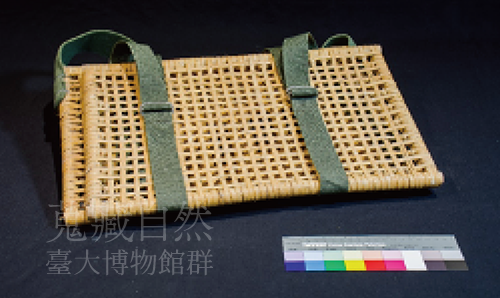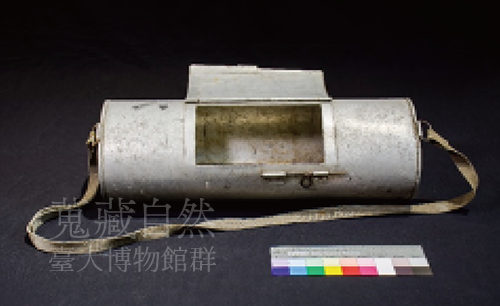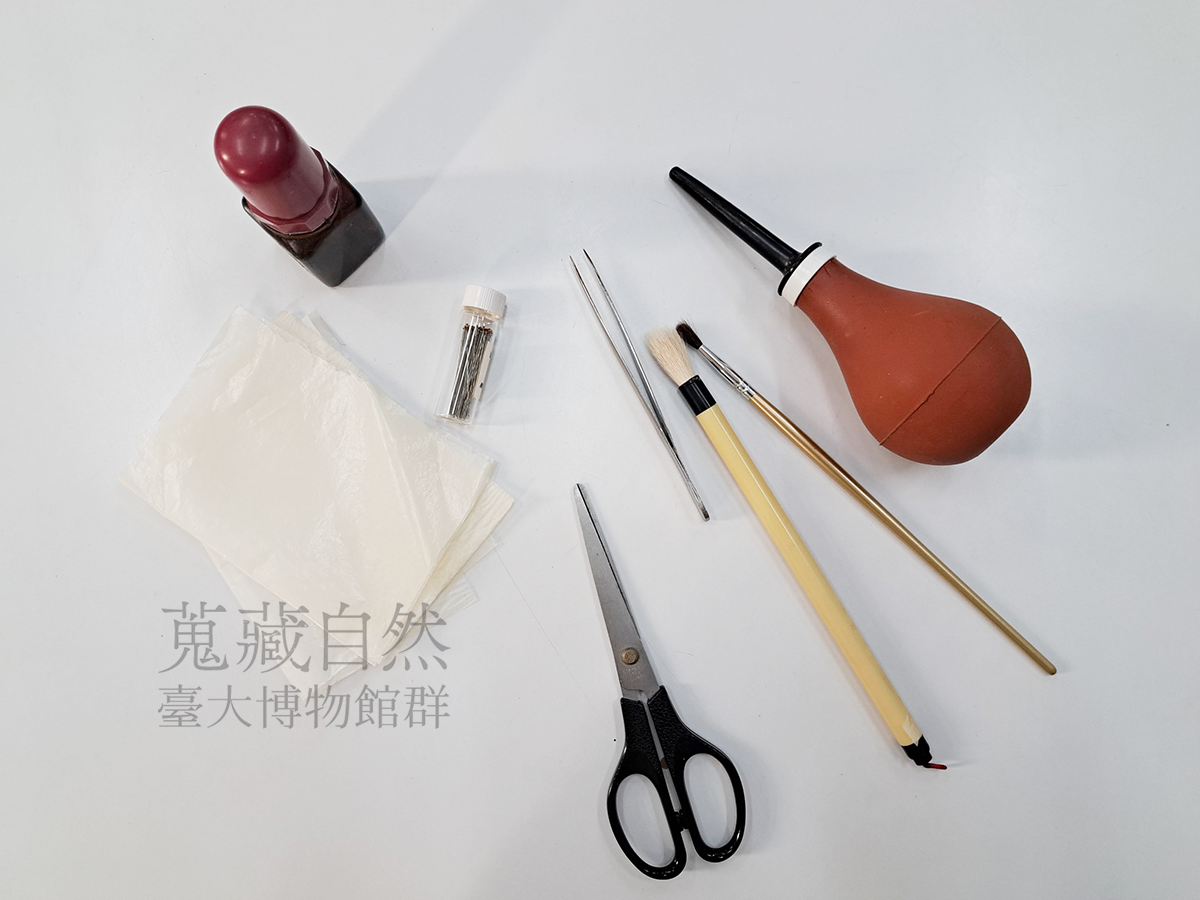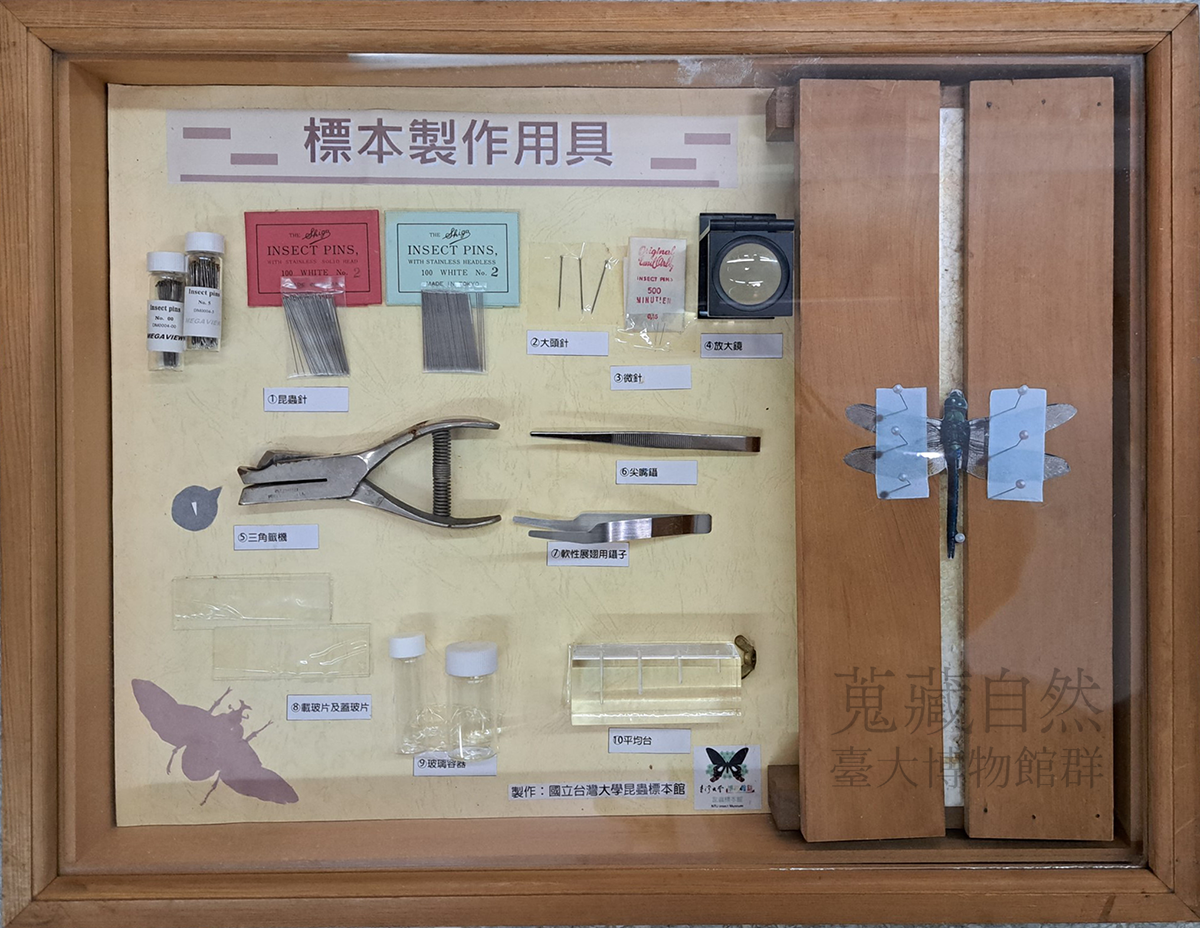其他成果 Others
自然史標本採集與典藏
Collection and Preservation of Natural History Specimen
自然史學科研究中,標本的採集與收藏為重要的一環,不同學科的採集方法依其目標物而有差異,典藏方法與保存環境也各有不同。本展場展示昆蟲和植物的各式採集工具,包含昆蟲標本袋、蟲籤等野外採集和暫存標本所使用的工具,以及植物野外採集時的鋁筒和標本乾燥夾等。
Specimen collection and preservation are important steps in natural history studies. As there are different collection methods in accordance with the targets in each discipline, the techniques and the environment for preserving them are unique to each field as well. Specimen bags, labels, storage for insect specimens, as well as alumni container for plant materials and drying plates are demonstrated here.

藤製採集夾
Rattan Press
製作成腊葉標本時,會使用藤製採集夾與吸水紙壓制植物標本,以達到吸乾植物水分的效果,且相較於木製或鐵製標本夾,藤製標本夾重量較輕,野外攜帶較方便。本件採集夾為重製複刻品。
Rattan plant field presses and absorbent paper are used to press Herbarium specimens to absorb excess water. Compared with wooden or iron plant field presses, rattan ones are lighter in weight and easier to carry in the wild. This one is recently reproduced.

鋁製採集桶
Aluminum Collection Box
早期採集者或學者們於野外採集會利用鋁製採集桶盛裝植物標本以防擠壓、破壞等;此外,鋁製採集桶亦可防止標本過快的水分散失。而現今此一物件多被塑膠製之夾鏈袋等較輕便之容器取代。
Early collectors or scholars used aluminum collection boxes to contain plant specimens when collecting in the wild to prevent the specimens from being squeezed or damaged. In addition, aluminum collection boxes also prevent the specimens from being dehydrated too quickly. Nowadays, this object is mostly replaced by lighter materials such as plastic zipper bags.

昆蟲標本的保存與維護
Preservation and Maintenance of Insect Specimens
將昆蟲製作成昆蟲標本後,需要妥善保存,否則標本會受到黴菌寄生或標本蟲啃咬造成標本毀損,因此典藏室內需要控制溫度及濕度避免黴菌生長。目前是以冷氣機和除濕機控制溫度和濕度。為了防範標本蟲啃食,會於標本盒外框添加樟腦砂,樟腦砂為標本蟲之忌避物,但是無法毒殺標本蟲。
After the insects are turned into specimens, they need to be properly stored. Otherwise, the specimens will be damaged by molds or gnawed by specimen pests. Therefore, the temperature and humidity in the specimen room should be controlled to prevent mold. Currently, this is achieved with air conditioners and dehumidifiers. To prevent specimen pests from consuming the specimens, camphor powder is placed on the outer frame of the specimen box. Specimen pests avoid camphor powder, but they not poisoned.

昆蟲標本的修復
Restoration of Insect Specimens
若標本不慎被黴菌寄生或標本蟲啃咬毀損,可將標本盒使用塑膠袋套起後,置於冷凍庫冷凍兩天,以殺死標本蟲;回溫後再使用烘箱低溫烘烤,以乾燥標本;最後再使用毛筆將黴菌及啃咬碎屑清理乾淨。若標本因碰撞造成附肢掉落,需具有昆蟲形態學知識,使用標本膠將掉落的附肢黏回。或使用蠟光紙將掉落附肢收納好,與標本固定於同一根昆蟲針;或以另一根昆蟲針插在標本旁邊。
If the specimen is damaged by mold or specimen pests, the specimen box can be wrapped in a plastic bag and placed in a freezer for two days to kill the specimen pests. Upon returning to room temperature, the specimen is baked in a low temperature in the oven to dry. Last but not least, the mold and debris are cleaned up with a fine brush. If the appendages fall off due to collision, knowledge of insect morphology is required to glue it back. Another possibility is storing the fallen appendages in waxed paper before fixing it with the same specimen pin, or placing it next to the specimen with another specimen pin.

標本製作工具
Specimen Making Tools
昆蟲的種類繁多,因應不同昆蟲類群及研究需求會將昆蟲標本製作成不同類型的昆蟲標本。製作成標本後才能將昆蟲身上的特徵完整的保存,並方便後續研究及整理。圖為各式現代標本製作工具。
There is a variety of insects. Insects are turned into different types of specimens with their groups and research needs taken into consideration. Only after the specimens are made can the characteristics of the insects be completely preserved, which facilitates subsequent research and sorting. The picture shows various modern specimen making tools.